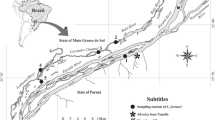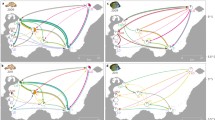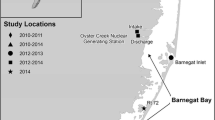Abstract
The relationship between larval supply and settlement is an integral part of the demographic processes of benthic marine organisms that determine their distribution at subsequent life stages. In ascidians, a strong positive relationship between larval supply and settlement has been previously documented, but only at small spatial scales (one location) and short time scales (less than one day). We investigated how this relationship might scale up by sampling larval abundance and settlement of a colonial ascidian (Botryllus schlosseri) across mesoscales (100 s of m) of the anthropogenic seascape of a 1.5-ha marina. Settlement varied vertically with a linear decrease in settlement with increasing depth. This pattern corresponded to the vertical distribution of larvae in the morning, when they were most abundant. However, larval abundance explained only 26% of the variation in settlement at the meso-spatial scale (i.e. the combined effect of the horizontal and vertical dimensions). This weakening of the relationship between larval supply and settlement suggests that the two processes may become decoupled at larger spatial and temporal scales. Our study underscores how changing the scales of sampling may affect our understanding of larval dispersal and settlement processes.







Similar content being viewed by others
Data availability
The data generated during the present study are available from the corresponding author upon request.
References
Bingham, B. L. & C. M. Young, 1991. Larval behaviour of the ascidian Ecteinascidia turbinata Herdman; an in situ experimental study of the effects of swimming on dispersal. Journal of Experimental Marine Biology and Ecology 145: 189–204.
Bourque, D., J. Davidson, N. G. MacNair, G. Arsenault, A. R. LeBlanc & G. Miron, 2007. Reproduction and early life history of an invasive ascidian Styela clava Herdman in Prince Edward Island, Canada. Journal of Experimental Marine Biology and Ecology 342: 78–84.
Boyd, H. C., S. K. Brown, J. A. Harp & I. L. Weissman, 1986. Growth and sexual maturation of laboratory-cultured Monterey Botryllus schlosseri. The Biological Bulletin 170: 91–109.
Broitman, B. R., C. A. Blanchette, B. A. Menge, J. Lubchenco, C. Krenz, M. Foley, P. A. Raimondi, D. Lohse & S. D. Gaines, 2008. Spatial and temporal patterns of invertebrate recruitment along the west coast of the United States. Ecological Monographs 78: 403–421.
Casso, M., M. Navarro, V. Ordóñez, M. Fernández-Tejedor, M. Pascual & X. Turon, 2018. Seasonal patterns of settlement and growth of introduced and native ascidians in bivalve cultures in the Ebro Delta (NE Iberian Peninsula). Regional Studies in Marine Science 23: 12–22.
Collin, S., 2013. Optimisation des stratégies de surveillance pour la détection précoce d’un tunicier envahissant par l’évaluation des mécanismes et des patrons de recrutement. PhD Thesis, Université Laval.
Collin, S. B., P. K. Edwards, B. Leung & L. E. Johnson, 2013. Optimizing early detection of a non-indigenous species: Estimating the scale of dispersal of a nascent population of the invasive tunicate Ciona intestinalis (L.). Marine Pollution Bulletin 73: 64–69.
Collin, S. B. & L. E. Johnson, 2014. Invasive species contribute to biotic resistance: Negative effect of caprellid amphipods on an invasive tunicate. Biological Invasions 16: 2209–2219.
Connell, J. H., 1985. The consequences of variation in initial settlement vs. post-settlement mortality in rocky intertidal communities. Journal of Experimental Marine Biology and Ecology 93: 11–45.
Crisp, D. J. & A. F. A. A. Ghobashy, 1971. Responses of the larvae of Diplosoma listerianum to light and gravity. In: Crisp DK (ed) Fourth European Marine Symposium, 443–465.
Davis, A. R. & A. J. Butler, 1989. Direct observations of larval dispersal in the colonial ascidian Podoclavella moluccensis Sluiter: Evidence for closed populations. Journal of Experimental Marine Biology and Ecology 127: 189–203.
Desplanque, C. & D. J. Mossman, 2004. Tides and their seminal impact on the geology, geography, history, and socio-economics of the Bay of Fundy, eastern Canada. Atlantic Geology 40: 1–130.
DiBacco, C., D. Sutton & L. McConnico, 2001. Vertical migration behavior and horizontal distribution of brachyuran larvae in a low-inflow estuary: implication for bay-ocean exchange. Marine Ecology Progress Series 217: 191–206.
Environment and Climate Change Canada, 2019. Historical climate data. Meteorological Service of Canada, Toronto, Canada [available on internet at https://climate.weather.gc.ca/ Accessed 16 Dec 2019].
Epelbaum, A., C. M. Pearce, D. J. Barker, A. Paulson & T. W. Therriault, 2009. Susceptibility of non-indigenous ascidian species in British Columbia (Canada) to invertebrate predation. Marine Biology 156: 1311–1320.
Forward Jr., R. B., J. M. Welch & C. M. Young, 2000. Light induced larval release of a colonial ascidian. Journal of Experimental Marine Biology and Ecology 248: 225–238.
Gaines, S., S. Brown & J. Roughgarden, 1985. Spatial variation in larval concentrations as a cause of spatial variation in settlement for the barnacle, Balanus glandula. Oecologia 2: 267–272.
Garrison, L. P., 1999. Vertical migration behaviour and larval transport in brachyuran crabs. Marine Ecology Progress Series 176: 103–113.
Grave, C. & H. Woodbridge, 1924. Botryllus schlosseri (Pallas): The behavior and morphology of the free-swimming larva. Journal of Morphology and Physiology 39: 207–247.
Grosberg, R. K., 1982. Intertidal zonation of barnacles: the influence of planktonic zonation of larvae on vertical distribution of adults. Ecology 63: 894–899.
Grosberg, R. K., 1987. Limited dispersal and proximity-dependent mating success in the colonial ascidian Botryllus schlosseri. Evolution 41: 372–384.
Hare, J. A., J. A. Quinlan, F. E. Werner, B. O. Blanton, J. J. Govoni, R. B. Forward, L. R. Settle & D. E. Hoss, 1999. Larval transport during winter in the SABRE study area: results of a coupled vertical larval behaviour—three-dimensional circulation model. Fisheries Oceanography 8: 57–76.
Hurlbut, C. J., 1991. The effects of larval abundance, settlement and juvenile mortality on the depth distribution of a colonial ascidian. Journal of Experimental Marine Biology and Ecology 150: 183–202.
Hurlbut, C. J., 1992. Larval release and supply predict temporal variation in settlement of a colonial ascidian. Marine Ecology Progress Series 80: 215–219.
Hurlbut, C. J., 1993. The adaptive value of larval behavior of a colonial ascidian. Marine Biology 115: 253–262.
Johnson, D. R., 1985. Wind-forced dispersion of blue crab larvae in the Middle Atlantic Bight. Continental Shelf Research 4: 733–745.
Kanamori, M., K. Baba, M. Natsuike & S. Goshima, 2017. Life history traits and population dynamics of the invasive ascidian, Ascidiella aspersa, on cultured scallops in Funka Bay, Hokkaido, northern Japan. Journal of the Marine Biological Association of the United Kingdom 97: 387–399.
Keough, M. J. & B. J. Downes, 1986. Effects of settlement and post-settlement mortality on the distribution of the ascidian Trididemnum opacum. Marine Ecology Progress Series 33: 279–285.
Kinlan, B. P. & S. D. Gaines, 2003. Propagule dispersal in marine and terrestrial environments: a community perspective. Ecology 84: 2007–2020.
Koehl, M. R. A., 2007. Mini review: hydrodynamics of larval settlement into fouling communities. Biofouling 23: 357–368.
Lewin, R., 1986. Supply-side ecology. Science 234: 25–27.
Ma, K. C. K., D. Deibel, J. B. Lowen & C. H. McKenzie, 2017. Spatio-temporal dynamics of ascidian larval recruitment and colony abundance in a non-indigenous Newfoundland population. Marine Ecology Progress Series 585: 99–112.
Manríquez, P. H. & J. C. Castilla, 2007. Roles of larval behaviour and microhabitat traits in determining spatial aggregations in the ascidian Pyura chilensis. Marine Ecology Progress Series 332: 155–165.
Manríquez, P. H., J. C. Castilla, V. Ortiz & M. E. Jara, 2016. Empirical evidence for large-scale human impact on intertidal aggregations, larval supply and recruitment of Pyura praeputialis around the Bay of Antofagasta, Chile. Austral Ecology 41: 701–714.
Marshall, D. J., J. A. Pechenik & M. J. Keough, 2003. Larval activity levels and delayed metamorphosis affect post-larval performance in the colonial ascidian Diplosoma listerianum. Marine Ecology Progress Series 246: 153–162.
McKenzie, C. H., K. Matheson, S. Caines & T. Wells, 2016. Surveys for non-indigenous tunicate species in Newfoundland, Canada (2006 – 2014): a first step towards understanding impact and control. Management of Biological Invasions 7: 21–32.
Menge, B. A., 2000. Recruitment vs. postrecruitment processes as determinants of population abundance. Ecological Monographs 70: 265–288.
Millar, R. H., 1971. The biology of ascidians. Advances in Marine Biology 9: 1–100.
Minchinton, T. E. & R. E. Scheibling, 1991. The influence of larval supply and settlement on the population structure of barnacles. Ecology 72: 1867–1879.
Miron, G., B. Boudreau & E. Bourget, 1995. Use of larval supply in benthic ecology: testing correlations between larval supply and larval settlement. Marine Ecology Progress Series 124: 301–305.
Morgan, S. G. & J. L. Fisher, 2010. Larval behavior regulates nearshore retention and offshore migration in an upwelling shadow and along the open coast. Marine Ecology Progress Series 404: 109–126.
Morgan, S. G., J. L. Fisher & J. L. Largier, 2011. Larval retention, entrainment, and accumulation in the lee of a small headland: Recruitment hot spots along windy coasts. Limnology and Oceanography 56: 161–178.
O’Connor, M.I., J. F. Bruno, S. D. Gaines, B. S. Halpern, S. E. Lester, B. P. Kinlan & J. M. Weiss, 2007. Temperature control of larval dispersal and the implications for marine ecology, evolution, and conservation. Proceedings of the National Academy of Sciences of the United States of America 104: 1266–1271.
Olson, R. R., 1983. Ascidian-Prochloron symbiosis: The role of larval photoadaptations in midday larval release and settlement. The Biological Bulletin 165: 221–240.
Olson, R. R., 1985. The consequences of short-distance larval dispersal in a sessile marine invertebrate. Ecology 66: 30–39.
Olson, R. R. & R. McPherson, 1987. Potential vs. realized larval dispersal fish predation on larvae of the ascidian Lissoclinum patella (Gottschaldt). Journal of Experimental Marine Biology and Ecology 110: 245–256.
Petersen, J. K. & I. B. Svane, 1995. Larval dispersal in the ascidian Ciona intestinalis (L.). Evidence for a closed population. Journal of Experimental Marine Biology and Ecology 186: 89–102.
Pineda, J., J. A. Hare & S. Sponaugle, 2007. Larval transport and dispersal in the coastal ocean and consequences for population connectivity. Oceanography 20: 22–39.
Pineda, J., F. Porri, V. Starczak & J. Blythe, 2010. Causes of decoupling between larval supply and settlement and consequences for understanding recruitment and population connectivity. Journal of Experimental Marine Biology and Ecology 392: 9–21.
Pineda, M. C., C. D. McQuaid, X. Turon, S. López-Legentil, V. Ordóñez & M. Rius, 2012. Tough adults, frail babies: an analysis of stress sensitivity across early life-history stages of widely introduced marine invertebrates. PLOS ONE 7: e46672.
R Core Team, 2019. R: a language and environment for statistical computing. R Foundation for Statistical Computing, Vienna, Austria [available on internet at https://www.r-project.org/].
Rius, M., E. E. Potter, J. D. Aguirre & J. J. Stachowicz, 2014. Mechanisms of biotic resistance across complex life cycles. Journal of Animal Ecology 83: 296–305.
Roughgarden, J., S. Gaines & S. Pacala, 1987. Supply side ecology: the role of physical transport processes. In: Gee J. H. R. & P. S. Gille (eds) Organization of Communities, Past and Present. The 27th Symposium of the British Ecological Society, Blackwell Scientific Publications, Oxford, pp 491–518.
Sephton, D., B. Vercaemer, J. M. Nicolas, J. Keays, 2011. Monitoring for invasive tunicates in Nova Scotia, Canada (2006-2009). Aquatic Invasions 6: 391–403.
Simkanin, C., P. W. Fofonoff, K. Larson, G. Lambert, J. A. Dijkstra & G. M. Ruiz, 2016. Spatial and temporal dynamics of ascidian invasions in the continental United States and Alaska. Marine Biology 163: 163.
Stoner, D. S., 1990. Recruitment of a tropical colonial ascidian: relative importance of pre-settlement vs. post-settlement processes. Ecology 71: 1682–1690.
Stoner, D. S., 1992. Vertical distribution of a colonial ascidian on a coral reef: the roles of larval dispersal and life-history variation. The American Naturalist 139: 802–824.
Svane, I. B. & C. M. Young, 1989. The ecology and behaviour of ascidian larvae. Oceanography and Marine Biology: An Annual Review 27: 45–90.
Thorson, G., 1950. Reproductive and larval ecology of marine bottom invertebrates. Biological Reviews 25: 1–45.
Todd, C. D., P. J. C. Phelan, B. E. Weinmann, A. R. Gude, C. Andrews, D. M. Paterson, M. E. Lonergan & G. Miron, 2006. Improvements to a passive trap for quantifying barnacle larval supply to semi-exposed rocky shores. Journal of Experimental Marine Biology and Ecology 332: 135–150.
Underwood, A. J. & P. G. Fairweather, 1989. Supply-side ecology and benthic marine assemblages. Trends in Ecology & Evolution 4: 16–20.
White, J. W. & J. E. Caselle, 2008. Scale-dependent changes in the importance of larval supply and habitat to abundance of a reef fish. Ecology 89: 1323–1333.
White, J. W., J. F. Samhouri, A. C. Stier, C. L. Wormald, S. L. Hamilton & S. A. Sandin, 2010. Synthesizing mechanisms of density dependence in reef fishes: behavior, habitat configuration, and observational scale. Ecology 91: 1949–1961.
Whitlatch, R. B. & R. W. Osman, 2009. Post-settlement predation on ascidian recruits: predator responses to changing prey density. Aquatic Invasions 4: 121–131.
Wing, S. R., J. L. Largier, L. W. Botsford & J. F. Quinn, 1995. Settlement and transport of benthic invertebrates in an intermittent upwelling region. Limnology and Oceanography 40: 316–329.
Young, C. M., 1987. The novelty of “supply-side ecology”. Science 235: 415–416.
Young, C. M., 1990. Larval ecology of marine invertebrates: a sesquicentennial history. Ophelia 32: 1–48.
Young, C. M. & F. S. Chia, 1984. Microhabitat-associated variability in survival and growth of subtidal solitary ascidians during the first 21 days after settlement. Marine Biology 81: 61–68.
Young, C. M. & F. S. Chia, 1985. An experimental test of shadow response function in ascidian tadpoles. Journal of Experimental Marine Biology and Ecology 85: 165–175.
Yund, P. O., S. D. Gaines & M. D. Bertness, 1991. Cylindrical tube traps for larval sampling. Limnology and Oceanography 36: 1167–1177.
Yund, P. O. & A. Stires, 2002. Spatial variation in population dynamics in a colonial ascidian (Botryllus schlosseri). Marine Biology 141: 955–963.
Acknowledgements
We thank Leonardo Miranda and Caroline Potvin for their invaluable assistance in the field and the Natural Sciences and Engineering Research Council (NSERC), Fisheries and Oceans Canada, Québec-Océan, and Université Laval for financial and logistical support for the Canadian Aquatic Invasive Species Network II (CAISN II) within which this study was done. The management and users of the Ben Eoin Marina are gratefully acknowledged for granting us access to their floating docks and facilities. We are also thankful to Andrea Weise, Heather Hawk, Kathleen MacGregor, Filippo Ferrario, and Nathan Haag for logistical support and editorial feedback. We are grateful to the anonymous reviewers who have greatly improved this manuscript with their suggestions and comments.
Funding
This study was funded with the financial and in-kind support from the Natural Sciences and Engineering Research Council of Canada (NSERC) Canadian Aquatic Invasive Species Network II (CAISN II), Fisheries and Oceans Canada, Québec-Océan, and Université Laval.
Author information
Authors and Affiliations
Corresponding author
Ethics declarations
Conflict of interest
The authors declare that they have no conflicts of interest.
Research involving human and animal rights
The authors did not perform any experiments with human participants in this study. Care, handling, and use of animals in this study followed national guidelines.
Additional information
Handling editor: Iacopo Bertocci
Publisher's Note
Springer Nature remains neutral with regard to jurisdictional claims in published maps and institutional affiliations.
Electronic supplementary material
Below is the link to the electronic supplementary material.
Rights and permissions
About this article
Cite this article
Ma, K.C.K., McKindsey, C.W. & Johnson, L.E. Larval supply is a limited determinant of settlement at mesoscales across an anthropogenic seascape. Hydrobiologia 847, 4015–4029 (2020). https://doi.org/10.1007/s10750-020-04391-y
Received:
Revised:
Accepted:
Published:
Issue Date:
DOI: https://doi.org/10.1007/s10750-020-04391-y




